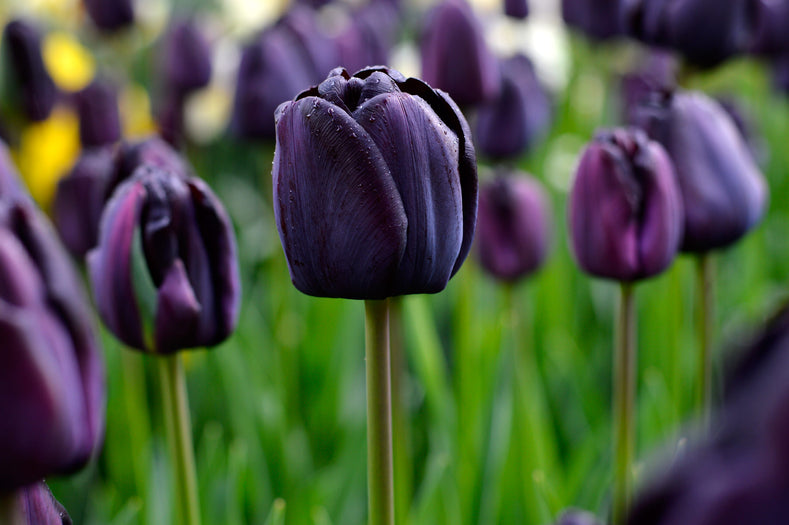Black tulips have been the holy grail of tulip breeders for centuries. It is rather like what you don’t have yet is what you want, just like a blue rose or a yellow snowdrop. Black is a colour laden with myth and associations which is why black coloured flowers excite and enthral us and none more so than the legendary black tulip.
Alexandre Dumas' novel "La Tulipe Noire” was published in 1850 and featured the quest for a black tulip in late seventeenth century Holland. It is a tale of jealousy, lust and desire and has inspired tulip growers ever since to produce the real thing.

Black tulips will probably never exist, but already what we do have is going to be just as good from a gardener’s point of view. Most gardeners will be familiar with the tulip ‘Queen of Night’. Its colour is very dark aubergine purple and the classic shaped flowers are held high quite late in the tulip flowering season; it is classified as a Single Late Group tulip.
Tulip ‘Queen of Night’ flowers at a time when many perennials are coming into flower in early spring and its dense dark blooms stand out perfectly when interplanted with such things as Aquilegias, Euphorbias, bleeding heart - Dicentra spectabilis and ground-covering Brunnera, Heuchera and Pulmonaria. Fresh foliage will also be expanding rapidly at this time of the year including that of daylilies, hostas and ferns, all of which make a perfect setting for ‘Queen of Night’s deep toned flower heads.
From a designer’s point of view, black is used to introduce depth into a scheme. In the garden a dark leaved shrub such as Cotinus coggygria 'Royal Purple' or a clump of “black leaved” Ligularia or indeed a group of black tulip flowers will appear to recede when associated with brighter colours. The points of darkness introduced into a planting scheme by black tulip flowers make sharp contrast with neighbouring lighter coloured flowers. Mix ‘Queen of Night’ with clear yellow flowered tulips such as Lily-flowered ‘West Point’ or the Single Late tulip, pink-flowered ‘Menton’ for sensational drama in your borders.

‘Black Hero’ is a double sport offspring of ‘Queen of Night’ and with twice as many petals it is even more effective in the garden. Double flowers, even though these are fairly small, need placing in sheltered positions to avoid damage from heavy rain and wind. I would take the risk, as these flowers are perhaps the darkest toned of any tulip currently available.
‘Vincent van Gogh’ has been honoured in the naming of a remarkable tulip with delicately fringed petals that are a dark brown version of burgundy red. This rich tone works really well with other red and purple coloured tulips. Rising out of a carpet of late double flowering tulips such as ‘Brownie’ it would be stunning especially if a few of the slightly higher growing ‘Black Hero’ tulips were added to the mix.

‘Black Parrot’ is undoubtedly my favourite out of this selection of garden worthy black flowered tulips. The colour has more life to it than the others; best described as maroon purple. As is the case with other Parrot Group tulips, the petals are ruffled and irregular. As such the flowers reflect the light at different angles and seem to bring more sparkle and drama to their surroundings. It flowers at the same time as the Viridiflora Group tulips such as ‘Spring Green’ and ‘China Town’ and makes a beautiful sophisticated contrast amidst their lighter tones. Underplant such a mixture with a carpet of Ajuga reptans ‘Atropurpurea’ or Heuchera ‘Palace Purple’ for something really special.
Black tulips may be dark and receding, but when used in combination with light toned spring flowers they are dramatically effective. Let the search for a really convincing true black continue, but for now I have all I need to bring punctuation to my spring planting schemes.

